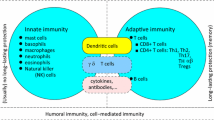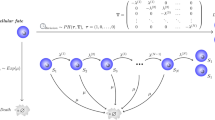Abstract
In this paper we introduce a simple framework which provides a basis for estimating parameters and testing statistical hypotheses in complex models. The only assumption that is made in the model describing the process under study, is that the deviations of the observations from the model have a multivariate normal distribution. The application of the statistical techniques presented in this paper may have considerable utility in the analysis of a wide variety of complex biological and epidemiological models. To our knowledge, the model and methods described here have not previously been published in the area of theoretical immunology.
Similar content being viewed by others
References
Agur, Z. and R. Mehr (1997). Modeling Trypanosoma congolense parasitaemia patterns during the chronic phase of infection in N’Dama cattle. Parasite Immunol. 19, 171–182.
Blower, S. M. and G. F. Medley (1992). Epidemiology, HIV & drugs: mathematical models & data. Br. J. Addict. 87, 31–39.
Detours, V., R. Mehr and A. Perelson (1999). A quantitative theory of affinity-driven T cell repertoire selection. J. Theor. Biol. 200, 389–403.
Detours, V., R. Mehr and A. Perelson (2000). Deriving quantitative constrains under which T cell selection operates from data on the mature T cell repertoire. J. Immunol. 164, 121–128.
Ferguson, S. F. (1996). A Course in Large Sample Theory, London, UK: Chapman and Hall.
Hardy, R. R., Y. S. Li, D. Allman, M. Asano, M. Gui and K. Hayakawa (2002). B-cell commitment, development and selection. Immunol. Rev. 175, 23–32.
Kirschner, D. (2001). Reconstructing microbial pathogenesis. ASM News 67, 567–573.
Kirschner, D., R. Mehr and A. Perelson (1998). The role of the thymus in HIV infection. J. AIDS Hum. Retrovirol. 18, 95–109.
Lehmann, E. L. and G. Casella (1998). Theory of Point Estimation, 2nd edn, NY: Springer.
Mehr, R. and A. Perelson (1997). Blind homeostasis and the CD4:CD8 ratio in the thymus and peripheral blood. J. AIDS Hum. Retrovirol. 14, 387–398.
Mehr, R., G. Shahaf, A. Sah and M. Cancro (2003). Asynchronous differentiation models explain bone marrow labeling kinetics and predict reflux between the pre-and immature B cell pools. Intl. Immunol. 15, 301–312.
Shannon, M. and R. Mehr (1999). Reconciling repertoire shift with affinity maturation: the role of deleterious mutations. J. Immunol. 162, 3950–3956.
Shlomchik, M., P. Watts, M. Weigert and S. Litwin (1998). Clone: a Monte-Carlo computer simulation of B cell clonal expansion, somatic mutation, and antigen-driven selection. Curr. Top. Microbiol. Immunol. 229, 173–197.
Author information
Authors and Affiliations
Corresponding author
Rights and permissions
About this article
Cite this article
Gorfine, M., Freedman, L., Shahaf, G. et al. Maximum likelihood estimator and likelihood ratio test in complex models: An application to B lymphocyte development. Bull. Math. Biol. 65, 1131–1139 (2003). https://doi.org/10.1016/S0092-8240(03)00062-4
Received:
Accepted:
Issue Date:
DOI: https://doi.org/10.1016/S0092-8240(03)00062-4




